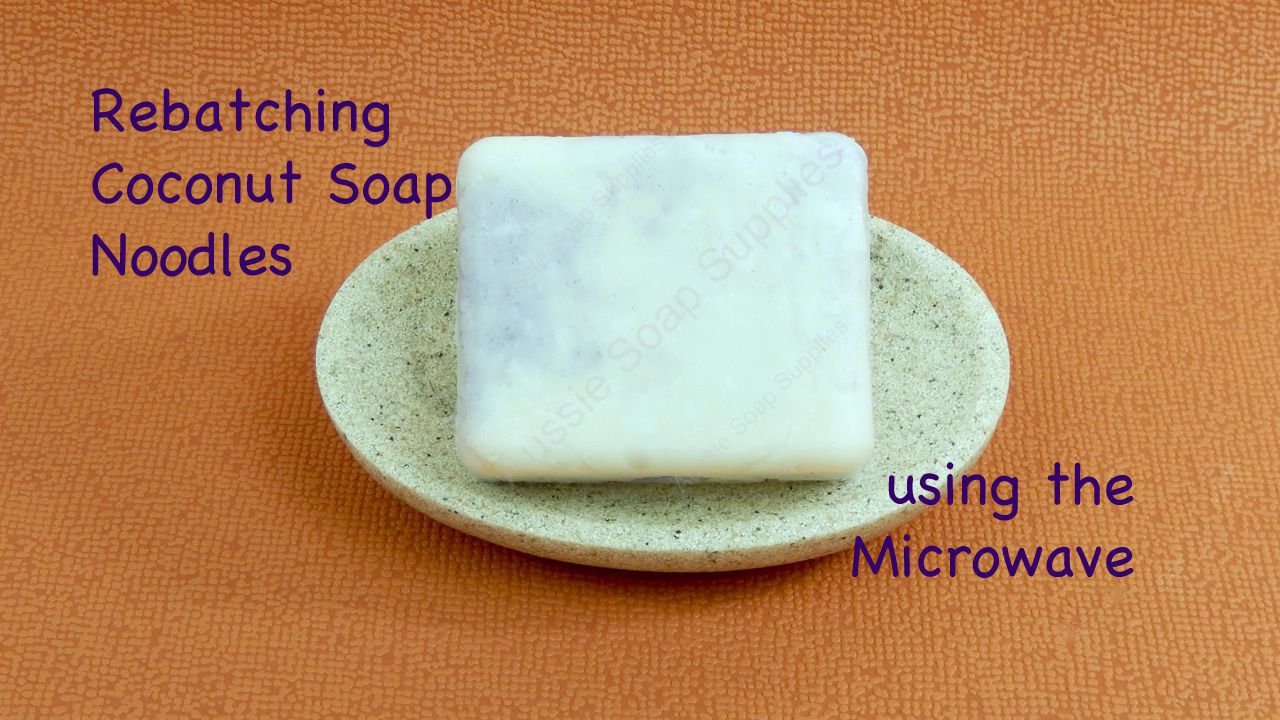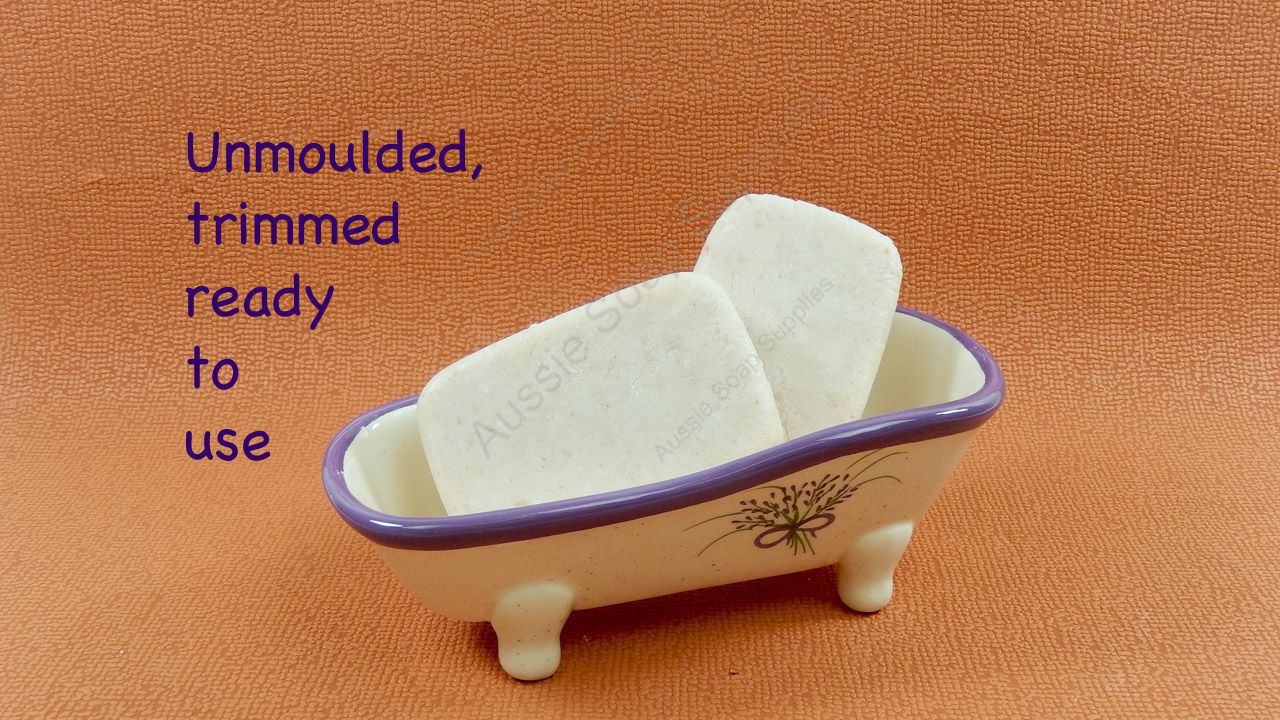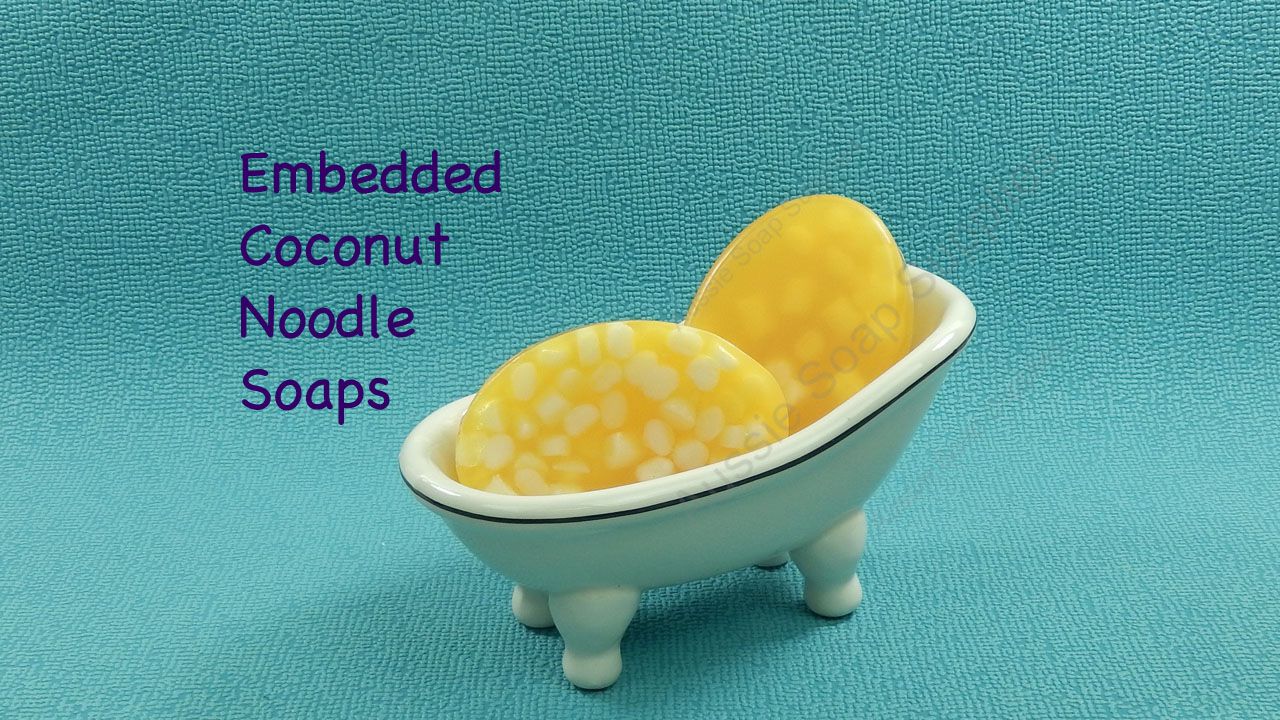Recipes Using Our Soap Noodles

Our Coconut Soap Noodles are now deleted, but we have left this tutorial and recipes in the formulary for customers who already have them! (99% of Soap Noodles made from Palm Oil and its derivatives), but our noodles are pure Coconut Oil, and are organic.
Our Coconut Soap Noodles are suitable for those wanting to make their own soap, but want to avoid handling Sodium Hydroxide (Lye) - or for those who want something a little more relaxing than Cold Process Soaping and worrying about trace and seizing fragrances! Our Soap Noodles are made from Coconut Oil only, no palm or any palm derivatives and can be incorporated into Melt & Pour Soap or "re-batched" into your own creative soaps.
When using Coconut Soap Noodles you are basically re-batching soap, so the texture is never going to be pourable, like Cold Processed Soap - it is ready for the moulds when it's smoothish and gloppy! Our Noodles are not dry and crumbly (if you have stored the noodles a bit long and they dry out, they should be crushed into a granule or powder before use). Then they are heated until squishy and mixed with other goodies then spooned into moulds to make your own handmade soaps!
We use three methods to process our noodles:
Microwave processing, Crock Pot Processing and embedding into Melt and Pour Soap - so after watching the slide show you can scroll on down to see written instructions for each method. (The easiest method to use is the Crock Pot Method if you have one as the stick blender does the work for you)
Tips:
-
Liquid measurements are a guide only - there are no exact measurements as it will depend on the moisture content of the noodles you are using and how long you heat them. The soap should be “thick and gloppy” with as few lumps as possible when you dollop it into the moulds.
-
Plain, unadorned moulds are the most suitable for Soap Noodle soaps - and silicone are not recommended as a rigid walled mould is the easiest to fill and unmould
-
Tap the mould firmly between each cavity as it's poured to ensure all the air has come away.
-
Work quickly as the soap sets as it cools rapidly as it's spooned into the moulds
-
Do use the freezer - it really helps the texture and finish of the bars
Microwave Method (with hand mixing)

Ingredients
- 300g Coconut Soap Noodles, Organic
- 30g Coco-Olive Liquid Soap
- 30g Distilled Water
- 30g Fixed oil such as Hemp, Almond, Apricot etc
- Drops of Royal Purple Liquid Dispersion - you'll need to decide how dark to go as you mix the colour through the soap
- 10ml (2 teaspoons) Fragrance Oil
- HD Chunky Rectangle Mould
Equipment
- Stick Blender
- Blunt knife, spatulas, spoons etc
- Pyrex or microwave safe jug - 500ml to 750ml are most suitable
- Smaller beakers,and/or jugs for additives
- Pot Mitt - the pyrex jug can get hot!
Moisture content required for processing will vary depending on how long you have cooked the noodles, your climate and size of the batch.
Method:
-
Weigh Noodles and place into jug, lightly cover and place in microwave to begin the cooking - keep the noodles covered except when mixing
-
Heat in bursts of 30 seconds to 1 minute - TAKE CARE! 300g can quickly burn in a microwave, so don't leave the soap unattended whilst heating
-
Prepare liquids and additives and set aside
-
Check the noodles frequently, and if they are starting to look a little translucent remove and begin to squish and crush them - squidge them into submission! If they are still too hard, continue heating in short bursts until you reach that stage
-
Once they have reached that stage add the liquid ingredients except for the fragrance or essential oil and colourant
-
When you have achieved a thick paste, add the fragrance, adjust the liquid content as desired to enable you to glop the mixture
-
Now add the liquid colourant, a few drops at a time, until you reach a colour depth you are happy with
-
Spoon into the mould cavities - tap each one to ensure the air bubbles are expelled, and move onto the next one
-
Place the mould straight into the freezer and leave for about 15 minutes or so
-
Remove and allow 5 minutes on the bench to allow the mould to warm up to room temperature (or you'll crack the mould)
-
Tap out the soaps onto the work bench. If they resist you can loosen them with a blunt edged knife and if they still don't fall out, back to the freezer for them as they have not chilled down sufficiently to remove from the mould.
- If you are working with just one mould sheet, don't forget to keep the rest of the mixture warm in between batches.
Crock Pot Method

Ingredients
- 700g Coconut Soap Noodles, Organic - into small crock pot
- 50g Sodium Lactate Plus
- 50g Hempseed Oil (or your favourite fixed oil)
- 50g Distilled Water
- 1 - 2 teaspoons Brazilian Pink Clay
- 2 teaspoons (10ml) Fragrance
- HD Mould - Rounded Rectangle (or similar)
Equipment
- Stick Blender
- Spatulas, spoons etc
- Crock Pot - small is best if you haven't made rebatch soap before
- Bowls and/or jugs
- Pot Mitt - the crock pot can get hot!
- Small sharp knife for trimming finished bars
Moisture content required for processing will vary depending on how long you have cooked the noodles, your climate and size of the batch.
Method:
-
Hydrate clay in some Distilled Water, Sodium Lactate or Hempseed Oil
-
Turn on crock pot to begin heating
-
Weigh Noodles and place into crock pot with the lid on and begin the cooking - keep the noodles covered except with beating with the blender
-
Prepare liquids and additives and set aside
-
After 30 to 45 minutes check the noodles, and if they are starting to look a little translucent give them a blast with the stick blender, if not, continue heating until you reach that stage
-
Once they have reached that stage add the liquid ingredients except for the fragrance or essential oil and colourant
-
When you have blended them into a thick paste, add the fragrance, adjust the liquid content as desired to enable you to glop the mixture
-
Now add the clay, 1 teaspoon at a time until you reach the depth of colour you are happy with
-
Spoon into the mould cavities - tap each one to ensure the air bubbles are expelled, and move onto the next one
-
Place the mould straight into the freezer and leave for about 10 minutes or so
-
Remove and allow 5 minutes on the bench to allow the mould to warm up to room temperature (or you'll crack the mould)
-
Tap out the soaps onto the work bench. If they resist you can loosen them with a blunt edged knife and if they still don't fall out, back to the freezer for them as they have not chilled down sufficiently to remove from the mould.
-
If you are working with just one mould sheet, don't forget to keep the mixture warm with the lid on between batches.
Embed into Melt & Pour Soap Method

Ingredients
- Coconut Soap Noodles, Organic
- Any Melt & Pour Soap Base
- 1 - 2 teaspoons Liquid Colourant (we used Sunflower Yellow Liquid Lake Dye)
- 2 teaspoons (10ml) Energy Fragrance or your preferred Fragrance or Essential Oil
- HD Mould - Oval (or similar)
Equipment
- Microwave safe jug
- Spatulas, spoons etc
- Small sharp knife for trimming finished bars
Method:
-
Melt the soap base in the microwave on medium in short bursts
-
Colour and scent the melted soap base
-
Pour a couple of mm of soap base into the mould cavities, spritz with alcohol
-
Spritz some soap noodles with alcohol and place onto the soap in the mould
-
Spray with alcohol again and then top up the moulds with liquid Melt and Pour Soap
-
Spritz to remove surface bubbles if necessary, allow to set up
Just in case you still use our old recipes, we've left them here (in brief) for you!
Lemon Tart Soaps
Makes 2 - 5 bars (depending on the size of the mould)
- 350g Coconut Soap Noodles, Organic
- 20g Organic Shea Butter
- ½ cup milk – either Cows or Soy (full fat versions work best in soap)
- 1 1/2 teaspoons (7ml) Lemon Verbena Fragrance
OR
- 1 1/2 teaspoons Lemon Essential Oil
- Yellow Dispersion Colour or Melt & Pour Sunflower Yellow Liquid
- Calendula Petals for decoration if desired
Allow to cool for a little while so that it is partially set up and cool enough to touch. Take handfuls and roll into balls and shapes with your hands.
Hand Moulded Floral Soaps
Makes 3 - 6 bars (depending on the size of the mould)
If you love flowers, do try these soaps! These are moulded in your hands, and then the moist soap is rolled in dried flower petals – try Lavender Buds, Calendula Petals, or even some dried green herbs you have growing, even parsley, fined chopped. The main thing is to ensure the botanicals are fully dried before you roll the moist soaps in them.
If you are going to us Sandalwood Powder or any culinary spices, take care during the first use as they may irritate the skin.
We suggest you wear disposable gloves for this recipe
- 500g Coconut Soap Noodles, Organic
- 20g Liquid oil of choice
- ½ cup milk – either Cows or Soy (full fat versions work best in soap)
- 1½ teaspoons Fragrance
or - 1 - 2 teaspoons (in total) Essential Oils of choice
a nice blend is: Lavender, Rose Geranium, Ylang Ylang, - Clay or Liquid Colour if desired
Beaded Rebatch Soaps
Makes 2 - 5 bars (depending on the size of the mould)
- 350g Coconut Soap Noodles, Organic
- 10g Organic Shea Butter, Organic
- ½ cup milk – either cows or Soy (full fat versions work best in soap)
- 1½ Teaspoons (8ml) Fragrance
or - 3g ( 2/3 teaspoon) teaspoons Rose Geranium Essential Oil or your EO of Choice
- Jojoba Beads
Tip: Add the Beads last. Don't overstir when combining the jojoba beads, just gently fold through and then mould immediately.
Honey N Orange Spice Soaps
Makes 2 - 5 bars (depending on the size of the mould).
- 300g Coconut Soap Noodles, Organic
- ½ cup milk – either Cow, Goat or Soy (full fat versions work best in soap)
- 2 teaspoons ground, dried Orange Peel
- 1 tablespoon of Honey Powder mixed into the millk or 1 teaspoon Liquid Honey
- 3g ( 2/3 teaspoon) Gingerbread Cookie Fragrance and 1 teaspoon Valencia Orange Essential Oil
Tropical Coconut Luxury Soaps
Makes 3 - 6 bars (depending on the size of the mould)
- 500g Coconut Soap Noodles, Organic
- 1/2 Cup Coconut Milk or Buttermilk Powder
- 40g Coconut Oil
- ½ Cup Milk – either Cows or Soy (full fat versions work best in soap)
- Toasted Dessicated Coconut – approximately 1 cup
- 2 Teaspoon (8ml) Coconut Cream Fragrance
or - 3g (2/3 teaspoon) Essential Oils
Try: Mandarin, Orange, Clove, Lime, Lemon or a combination of these
OR – simply leave these pure white, and unscented for a subtle Coconut Fragrance
- Liquid Colour if desired











